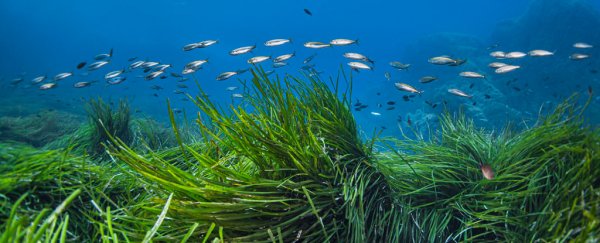Tropical rainforests are often called the lungs of our planet, sucking vast amounts of carbon dioxide from the atmosphere and puffing out oxygen in exchange. As it turns out, however, there are even bigger lungs in our oceans.
Seagrass meadows are vast fields of underwater plants capable of capturing carbon 35 times faster than tropical rainforests. Along with tundra, these coastal ecosystems are among the world's largest carbon sinks, yet we know surprisingly little about what fuels their high productivity.
A new study suggests these marine meadows would not be nearly as powerful at capturing carbon if it wasn't for a hidden hero concealed within the grass.
Living directly within the roots of Neptune grass (Posidonia oceanica), researchers in the Mediterranean have discovered a new type of bacteria, named Celerinatantimonas neptuna, which can turn nitrogen gas into a nutrient marine plants can actually use for photosynthesis.
That's strikingly similar to how plants on land capture nitrogen as well, and yet this type of symbiotic relationship has never been found among marine plants before.
The study only focused on a specific species of seagrass in the Mediterranean Sea, but because relatives of C. neptuna occur worldwide, the authors suspect similar relationships could be happening elsewhere, too.
"It was assumed that the so-called fixed-nitrogen for the seagrasses comes from bacteria that live around their roots in the seafloor," explains marine microbiologist Wiebke Mohr from the Max Planck Institute in Bremen, Germany.
"We now show that the relationship is much closer: The bacteria live inside the roots of the seagrass. This is the first time that such an intimate symbiosis has been shown in seagrasses."
Researchers identified the novel bacteria using microscopic techniques, where different bacterial species living in and between the root cells of Neptune seagrass are highlighted by different color labels.
Compared to the sandy sediment scattered around the seagrass, the authors found the plant itself was able to store more than eight times as much carbon dioxide. And that was true even when there were no detectable nitrogen nutrients in the water column.
The findings suggest something else was fixing nitrogen gas and converting it for the marine plant. Upon closer examination, the team found the microbiome of the plant's roots was not the same as the microbiome of the surrounding sediment.
The difference seemed to be driven mainly by a single bacterium, which the authors found exists in seagrass roots in the greatest quantities in the summertime, when nitrogen is most scarce. Once obtained, the nitrogen in these roots seems to spread quickly throughout the plant.
"This transfer was rapid, with up to around 20 percent of the freshly fixed nitrogen being assimilated into leaf biomass already within 24 h," the authors write.
In exchange, the team thinks the seagrass probably provides its resident bacteria with sugars – a symbiotic relationship we have previously overlooked and one that is possibly ancient.
Seagrasses are thought to have evolved around 100 million years ago from flowering plants that made their way back into the sea.
During this transition, the authors suspect the special root microbiomes already established for nitrogen-fixing on land were probably replaced by a marine version.
"They virtually copied the system that was highly successful on land and then, in order to survive in the nutrient-poor seawater, acquired a marine symbiont," Mohr surmises.
Where C. neptuna actually came from is another matter. Its genetic features suggest its ancestors lived in the coastal environment, where it was likely associated with seaweed, which doesn't have roots.
The closest relative alive today, on the other hand, come from the roots of saltmarsh grasses and tropical seagrasses, where the bacteria probably forms a similar symbiotic relationship as with seaweed (although this has yet to be confirmed).
"Just like [nitrogen]-fixing microorganisms might have aided the colonization of nitrogen-poor soils by early land plants," the authors write, "the ancestors of C. neptuna and its relatives probably enabled flowering plants to invade nitrogen-poor marine habitats, where they formed extremely efficient blue carbon ecosystems."
The authors now plan on studying the new root bacteria in the lab to see how nitrogen-fixing occurs in more detail. Mohr is excited to see whether other seagrass systems around the world rely on similar relationships.
Given how vital seagrass ecosystems are in our current climate crisis, it's about time we knew how they worked.
Especially given we're destroying seagrass meadows at an even faster rate than tropical rainforests.
The study was published in Nature.
